Crossings
Editor’s note: The veil between the worlds is very thin this morning, and my pal Marlow hit me right between the running lights this morning. We both can feel it; something in the air, or maybe the vibrations of the earth beneath our feet. I have felt this way before- a sense of foreboding that I cannot explain, but real as day. Like the summer of 2001…
Marlow and I have shared some times down through the years: life birth death and divorce. Ultimately infinity- but not just yet.
I have dragged you, Gentle Reader, to the gray and stormy Atlantic and the Wine Dark Sea of the Mediterranean in a distant year. It is filled with the minutia of life afloat and ashore. That is the life we lived in men of war. But there was another kind of life upon the waves, not a bellicose one, but a means of transit that was frankly tinged with the miraculous. Marlow nailed this one. He describes the way things were in a ship built the same year I was, and a way of life as incredible as a newsreel of the luxury of crossing the oceans by Zeppelin.
Join Marlow for the last crossing of the SS United States:
Vic
Crossings
From Marlow’s Life and Island Times
Forty-seven years ago, young Marlow crossed the Atlantic on the SS United States. He sailed to his sophomore year at a French university. He and his fellow students hung out in the first class lounge each and every day. They were not interlopers. An alum of their alma mater was a board member of the Cunard Lines. Through his largesse were they able to acquire first class accommodations at steerage prices.
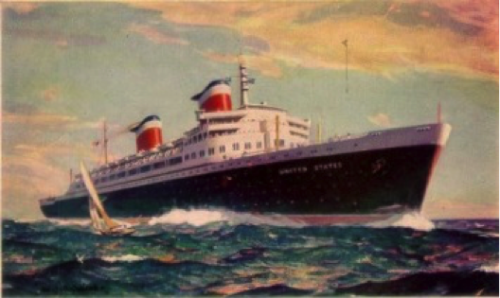
Postcard of Cunard Lines SS United States
She was a speed demon, setting the still existing time record for easterly crossing. Why all this speed? Her construction was underwritten by the U.S. government (two thirds of her cost would be half a billion in today’s dollars) to allow conversion to a troopship capable of carrying over 15,000 troops across the pond to bloody Europe in little more three days, Marlow was fortunate to sail on her last regularly scheduled crossing.
Since she was dual use, the designers of United States used no wood in the ship’s framing, accessories, decorations, or interior surfaces. Fittings, including all furniture and fabrics, were custom made in glass, metal, and spun glass fiber to ensure compliance with fireproofing guidelines set by the U.S. Navy. Specially commissioned artwork included pieces by fourteen artists, including Nathaniel Choate, muralist Austin M. Purves, Jr., and sculptor Gwen Lux. Even the clothes hangers in first class cabins were aluminum. The ballroom’s grand piano was made of fire-resistant wood species—although originally specified in aluminum. It was accepted only after a demonstration in which gasoline was poured upon the wood and ignited, without the wood itself igniting.
When she came into service in 1952, the SS United States was done in the most tasteful luxurious manner befitting her then unipolar power’s namesake. She was stunningly beautiful, sleek, lightweight due to her use of aluminum and capable of sustained 35 knot travel for over 10,000 nautical miles with full provisions for the crew and passengers. Her best fuel efficiency speed was 30 knots making her wake a churning rainbow cauldron at each and every sunset and sunrise. Her top speed was likely close to 45 knots.

SS United States first class lounge and ballroom
There was nothing like the first class lounge as the day waned. Elegant 25 cent cocktails in crystal glasses, monogrammed with the insignia of the Line, listening to the grand piano player playing the standards and the occasional request, playing bridge (or learning to do so poorly, with fellow college students and few non-flying swells from NYC and Philadelphia), and watching the sunset filled three precious hours each afternoon during the five day crossing.
Players drifted away as the sun dipped and dinner bongs were heard, calling away the first and second seatings for the evening meals. It was at this time, when the lounge became empty, immaculate and holy. With show tunes from the 30s playing, it silently transformed itself into a time machine, transporting the few remaining imbibers into the modernist 1930s.
Marlow did not understand the meaning of these moments and the visions he had until decades later. During these clairvoyant minutes he had visions of past and future events. He did not understand this gift. He clearly saw watery homes of steel and coral and children, while intensely feeling alternating sorrow and joy.
On his return voyage in 1969, it was the north Atlantic storm season. The lounge and dining rooms became empty with all but a few passengers becoming seasick and choosing to stay in their cabins as the ship rocked and rolled its way westward. The seas were rough, the skies endlessly grey and the weather decks windy, wet and slippery.
Marlow dined alone at most meals in the elegant first class dining room. The stewards offered him anything he wanted. Steaks, fish, shellfish, wines and desserts of unimaginable pleasure and taste were there for the taking, but he demurred, preferring to eat simply and avoid becoming a gargantuan glutton.
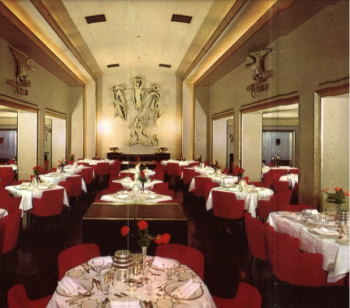
The first-class dining room looking aft toward the sculpture by Gwen Lux, entitled “The Four Freedoms.”
At one breakfast he began pondering the piece by sculptress Gwen Lux at the end of the dining room. Malvar, the head steward, told him upon questioning that its inspiration came from President Roosevelt’s 1941 State of the Union address.
FDR had proposed the idea of four fundamental freedoms that people “everywhere in the world” ought to enjoy: freedom of speech (from our constitution’s first amendment), freedom of worship (from the first amendment), freedom from want and freedom from fear (from FDR’s first inaugural speech). At that time every quadrant of Europe was being consumed by the fascist powers. The vessel he was sailing on was built in response to a third World War where the losses could be double, triple or quadruple those seen in the last Great War.
A Cold War now gripped the world to which Marlow was returning. The United States was undergoing a multipronged domestic revolution that seemingly threatened its very existence. Was a fascist response forthcoming from Washington DC’s new leaders? Was a temptress and corruptor on the scene about to play to our baser fears of fear itself? Time would tell.
As the sun rose in the east, Marlow entered the empty lounge. He chained-smoked Gauloise cigarettes, while waiting for the lounge to brighten each morning with a blue grey tint. The feelings of nine months prior came again; but, they were different, more akin to mourning and loss. Were they a sign of impending cataclysm? The world nearly blew itself up seven years prior and would nearly do so again in 1973 and 1983. They were slightly different this time, more akin to mourning and loss. Were they a sign of impending cataclysm?
Only having experienced the profound bereavement of a daughter’s, parents’ and shipmates losses in the ensuing years that followed do these two crossings’ brief moments begin to make sense.
The small indoor pool of the ship, reserved only for the ship’s luxury travelers, still remains in Marlow’s memory banks as deeply foreboding. Of what, he knows not.

Indoor pool of the SS United States.
The only connected dot amongst all these visions was that of water.
Copyright © 2016 From My Isle Seat
www.vicsocotra.www
Down on the Border
The excitement here is palpable! There are stories that the Administration may change their candidate as soon as May. That is unverified, of course, since that is the way journalism seems to work these days. There is some controversy about who might replace the incumbents.
May is still at least three months away in this endless campaign, so that topic will continue to percolate as each day goes by. What is closer, of course, is the situation at the Border. You probably have heard some of the publicity surrounding the Big Omnibus Bill in Congress. It is currently knocking about in the Senate of the United States. It is billed as “bipartisan” in formulation as part of the sales campaign to “Fix the Border!”
We have been talking about that for years now, and there is some discussion that an assortment of people in line to scoop up some of the vast amount of money we are poised to vote on tomorrow. The actual text of the bill has only been available for about 48 hours, and is over 300 pages in length. The only people who have actually read the whole thing are some of the Senators and the platoons of lobbyists for most of the issues contained in it.
The matter became controversial when the numbers started to leak out. Contained in the $118 Billion dollar legislation are things that meet the new requirement of our national lawmaking, which is that the effects of the omnibus bills have little to do with their actual contents.
The Senate Majority Leader wants to vote tomorrow, but despite the “bipartisan” description, there is word this morning that the Senate Minority leader is also voicing opposition to the Bill he helped to craft. That is the initial blow-back, and here are some of the reasons why.
US Senate releases draft bill to toughen border measures while securing aid to Ukraine and Israel
The $118bn bill includes $60bn in military assistance for Ukraine. As a point of magnitude, that is most of what is in the Bill. There is $14 Billion for Israel and $10 Billion in humanitarian assistance for civilians affected by war in Ukraine, Gaza and the West Bank.
So, that is most of the proposal, at $84 Billion. By comparison, we spend $53 Billion to have a Marine Corps. We have not arrived at anything directly related to the US-Mexico border. There is another $4.83 Billion to be used in support of US allies in the Indo-Pacific and to “deter China.” Since we also appear to be in some sort of proxy war in the Red Sea, another couple Billion goes to assisting US military operations against Houthi rockets in the Bab al Mendeb Strait.
That means over three quarters of the Border Bill has provisions for every other Border except ours. The lead drafter of the Senate minority side is a GOP member from Oklahoma, Sen. James Lankford. He seems close to giving up on the bill.
The word this morning is that the remaining- and stark minority- portion of the funds to be appropriated will have something to do with the line in the sand between us and the Mexicans. So at least we are continuing to name things as the inverse of their stated function.
So, that development will either be kicked down the road- like the 2024 Budget that was supposed to fund things starting last October- or kicked to the curb. Meanwhille, reports from the Border Control folks is that they have seen a dramatic increase in the number of young Chinese men passing north from….Mexico.
There has also been speculation on what they might be doing, or where they got the money to fly to Mexico from China in order to enter the US illegally. What border policy changes are included in the bill?
The legislation has been described as the “most severe set of changes to border policy in decades.” If passed, the bill would provide $20bn in funding to bolster and expand border security operations at a time when arrests for illegal crossings at the US-Mexican border have hit record highs.
Anyway, we will probably know about the Bill by close of business tomorrow. We won’t know what the Chinese fellows are up to for a while. Their presence may have something to do with influencing the election. We are considering writing our three members on the Hill- Virginia’s two Senators and the House member from our 8th District here in Arlington.
There are a lot of things that need to be addressed, and the Border Bill makes some provisions about all sorts of things. We tried to find the official name for the Bipartisan Border Bill, but we will have to leave it at that. They will have to find something else to call it, since we have run out of money to support Ukraine and the other global troubles.
Something will have to be done. Maybe we will hear about that tomorrow!
Copyright. 2024 Vic Socotra
Vic Socotra | Purveyor of glib words to the world
Money, Motivation and Messaging

The money part of this is in play. For the first time since 1910 we have an “interim Speaker” in the U.S. House of Representatives. Since the House is supposed to be the cash register for government, there was muttering about how the new war is going to be affected by the vacancy in our legislative hierarchy. Here at home, we were prepared to entertain the blood sampling specialist our Legal Department had scheduled for compliance with some regulation. And the tax bills came in from the County tax department down in Culpeper. We do not know if the timing is related. Those were two of the aspects of a day filled with unease and a little apprehension with rockets, war and great media coverage.
That was the part of a Saturday that was surreal. The imagery of the rockets fired seemed to reflect part of what was really going on. That is the part that tugs on the old obligations of the business of conflict. The numbers this morning are more specific than they were yesterday. Now, it is 600 dead Israeli civilians, two thousand more injured and a hundred hostages.
We are not analyzing the veracity of those figures. We are retired from actively muddling in our nation’s various affairs. For this crisis, we are attempting to follow the messaging to see what larger goals and aspirations are in play. It is not a demonstration of laziness on our part. We insist we are trying to stay alert and engaged. Our disengagement from active response is an attempt to understand what the people involved in the conflict want us to think. The aspect of interest on this particular bright morning is word that Americans- a couple dozen, perhaps- are among those taken hostage.
The messaging is comprehensive. You have doubtless seen the same spectacular clip of the massive mixed-use structure that was brought (mostly) down in Gaza City. It was strange at first glimpse. The explosions that took it out of the vertical orientation were well placed around the structure. The clip initially was presented as evidence of the savagery of the Palestinian attackers. Those of the Salts who used to do this for a living were a little mystified, since the explosions were so precisely placed as to bring down the structure without directly blasting adjacent buildings.
It was not until this morning that the captions on the video reflected the strike was actually conducted by the Israelis on a building- this is speculation- that supported Palestinian activities in the part of Gaza that was given to the Palestinian Authority (and Hamas) some 18 years ago.
The various angles of the building’s collapse suggested the imagery was captured and collated with an intent for effective messaging. That was a generally successful campaign through the day. Hamas fighters penetrated the walls about the Gaza Strip, thousands of rockets, possibly provided by Iran, impacted targets Hostages were taken. According to the Prime Minister of Israel, there is now a state of war between his nation and Hamas.
Regional events added to the messaging. The Abraham Accords are just one of the issues in play. Only five days ago, they were depicted by participants as a series of “agreements to normalize relations between Israel and several of the Arab states.” The name of the accords was used in references to the common heritage of the three major faiths with regional roots.
The Accords were named for Abraham, the ancient Patriarch and looked forward by declaring agreements between Israel and the United Arab Emirates, Bahrain and Morocco that had not existed since the founding of the Jewish State in 1948. The peace process exemplified by the Accords had been in process for almost two years and seemed to be lurching forward again in a positive manner for peace.
The amazing swirl behind it all includes kinetic and emotional factors. We have American hostages in the mix this morning. The Iranians are the players who may be losing influence in the regional calculus. Did American weapons compromised in Afghanistan wind up with Hamas? Did the $6 billion in Iranian assets recently “unfrozen” contribute to the ability of Hamas to unleash an impressive surprise?
We don’t know. We used to her that stray cats and dogs could trigger warnings of border crossings in Gaza. Could the 50th Anniversary of the 1973 Yom Kippur offensive against Israel not have placed the IDF on alert?
The other curious aspect of Israel’s “intelligence failure” was the remarkable string of successes by Israeli’s Mossad within Iran. One of the recent stories was of the successful theft of Iranian nuclear research records from a warehouse in Tehran. It was described as one of the most successful operations in Mossad history, so there is part of the Israeli intelligence structure that is not failing.
But we are left with questions about money and motivation. And messaging, of course. We will try to assess how those three aspects of modern warfare are progressing. In Ukraine we have followed the war with professional interest. The one that started yesterday apparently has American citizens held as hostages in a hotspot.
We may be retired, but this crisis has crossed a kinetic line and could move swiftly in unexpected directions.
Copyright 2023 Vic Socotra
www.vicsocotra.com
Neith: Goddess of the Hunt. And Me.
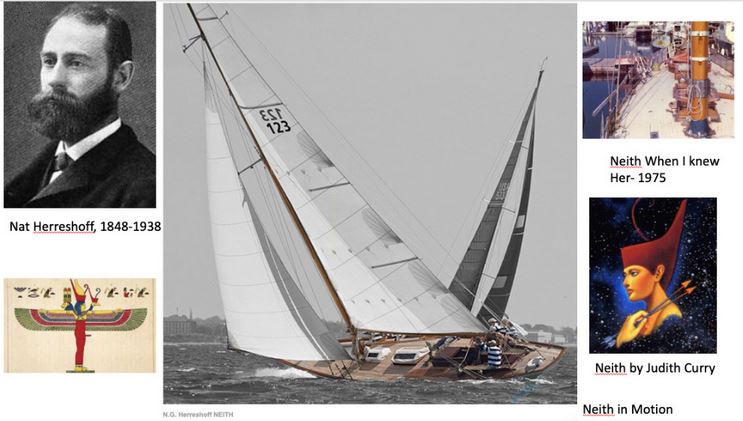 This is a story about a boat, so bear with me. It includes the modern manifestation of the Egyptian Goddess of the Hunt and record-setting ocean crossings. It only includes me for a few months, but it may have been a tipping point when something got in my blood and never could get rid of it. The object of my desire (at that time) was a lady 57-foot long, narrow on her beam and foc’sle you could do Shakespeare off of. She was designed by a man named Nathanial Herreshoff and therefore a connection to modern sailing history and industry. She is directly responsible for a long association with fairly-narrow and resolute mattresses and the smell of the sea.
This is a story about a boat, so bear with me. It includes the modern manifestation of the Egyptian Goddess of the Hunt and record-setting ocean crossings. It only includes me for a few months, but it may have been a tipping point when something got in my blood and never could get rid of it. The object of my desire (at that time) was a lady 57-foot long, narrow on her beam and foc’sle you could do Shakespeare off of. She was designed by a man named Nathanial Herreshoff and therefore a connection to modern sailing history and industry. She is directly responsible for a long association with fairly-narrow and resolute mattresses and the smell of the sea.
“Nat H” was known in the boat trade as the Wizard of Bristol. His story defines his age. He was born in 1848 before the Civil War and didn’t pass from this world until nearly the beginning of the Second World War. He was an earnest man of his time, but wild for innovative and brilliant design and boatbuilding. He had 70 years designing small and large sailboats and did not shy away from the power barges. He pioneered features common in today’s yachts, including sail tracks and slides, bulb keels, fin keels, and hollow aluminum masts. He also built one of the earliest catamarans seen on this side of the pond. So anything he touched has a connection to the way he saw how the waves worked in his time.
He was an end-to-end craftsman and a gifted navigator. He defended the America’s Cup six times, in: Vigilant, 1893; Defender, 1895; Columbia 1899 and 1901; Reliance, 1903; and Resolute, 1920.
So, good bones, good blood. The owners of Neith, named for the Mother of all gods in Rome’s pantheon, at that moment in 1975 were pals of college roommate Jim Forrest. She had returned across the ocean a bit bereft under command of some mariners of eccentric ways. Their tales still lingered on the piers, one about taking detailed navigational information from a thoroughly compromised taffrail log missing one blade. I have tried to live to that exacting standard since.
Ed Callahan was then-holder and had a lot on his plate, a young family and an ocean to manage. Jim was doing professional hardhat diving with his charming future wife Jeanette and there was a great circle of people doing actual things mostly oriented at the water. The boat was not sailable and needed mostly some cosmetic work, but otherwise empty. I spent the summer in a delightful culture of Beverly’s harbor. Berthed next door was a couple guys living on a big old schooner, and there were a string of young people on other boats to share the communal showers and latrines off the parking lot.
The boat that introduced me downstream to some of Nat Herreshoff’s ideas was built after Reliance, in 1907. Her name was Neith. She was special and personal, built for his own doctor. There was a clear and personal interest in her sleek slippery lines.
Neith was purpose-built as a Flush Deck Cutter and gentleman’s weekender. She was named in honor of the Egyptian Goddess of the Hunt. The Doctor and the Goddess parted ways, and by 1920 she was under her third master who attempted to take her east to England. Instead, she left Rhode Island and ran headlong into humiliating hurricane force winds.
She was pushed back and a bit battered. Commander Houghton was her owner and a determined man. he had her re-rigged as a yawl, and after a quick workup, was ready to cross the Atlantic. Under the Commander’s firm hand, Neith cast off in 1921 for a record-breaking Atlantic crossing. Houghton took her out of Halifax, Nova Scotia, and brought her to England in 25 days. He wasn’t satisfied with the record passage and wanted better performance from his sails.
From then on, Neith was a continental lady until just a few years before I met her. She spent her first half century in Europe, based in the UK, and raced throughout Scotland and Europe. The Commander campaigned her early and steadily. A sail-lady named Virginia Tweedy was quoted as saying “My grandparents were friends with the Houghtons and my grandfather often crewed the boat when she was in England, including in 1922 when Neith competed at Cowes and won on August 7th that year.”
So, she was racing well but the Commander wanted more. The new yawl rig had done well enough on the passage over, but did not perform as well as he desired. In 1926, he was talking to renowned yacht designer Charles Nicholson, who suggested a Marconi rig might improve the situation. The Commander gave her a Nicholson-style Marconi rig that she wears to this day. She remained in Scotland until 1970 when she returned to the US. She was still watertight when I left her at the end of 1976, but she sank while up on the Connecticut River and was abandoned.
When I was aboard in ’76, scraping old paint and living with the harbor gypsies there were still stories. One of them was about a Scottish owner who kept a bronze Egyptian image of the Goddess on the hearth of his home. It is said that when preparing to cast off or return to port, a salute in bagpipes was sounded and Neith was born from below-deck storage to a place of honor in the main cabin by the foot of the massive mast. It was all bare white paint when I was scraping it, but being alone on her in the night there was the feeling…maybe it was the paint thinner fumes.
That life in Beverly was in keeping Neith’s condition. Solid, but a bit down at the seams. Her lines were as grand as ever, but she needed a good yard period on the stilts. No one was in the financial condition to devote the money for a complete job. But we tried. The lines were fairly recent and the mast true.
She was worth saving, which is how a curious conversation occurred back in Michigan, about whether Dad would mind having a Marconi-rig flush deck 57-foot cutter on a brace in the side yard. Dad was kind enough not to howl in laughter at the money pit that implied, and to this day I have never invested in one. He did, though. But that conversation was the last direct interaction with her after one of those autumns that have magic in the air. She had remained in Scotland until she returned to the US in 1970. She was still watertight when I left her at the end of 1976, but sank while on the Connecticut River and was abandoned.
Ships can be homes, and I am glad I did not know of her status. Sinking is not necessarily a permanent condition, but altering it would require a significant investment. There was someone willing. He is described as “Third Owner” which with the modifying “unincumbered” word might be accurate. But he made the investment with a vision to preserve her. When they got her refloated, he had Neith restored well enough to participate in the prestigious Herreshoff Rendezvous in 1981.
Since then, the Lady has now been in one family for over thirty years and their standard was to keep her “Original Condition.” A major overhaul was just done a few years ago to keep her that way. In 2014, Taylor and Snediker Yacht Restoration did something any old wooden boat would want. Rather than a comprehensive restoration, this work was done in manner the family preferred. The company says nearly everything from the sheer planks up was replaced, her sheer line was restored to original specs, hull was strengthened with structural upgrades and replacement of structures with any degradation. The result was several awards including “Best Restoration,” “Judges Choice,” and the Centennial Society Award honoring vessels over a century old.
So, that is the only other ship I felt a part of that still lives, and why she still commands my interest. Midway is the other one. They don’t have an iota in common. And yet they are part of the same process against powerful and beautiful foe. The sea.
Copyright 2021 Vic Socotra
www.vicsocotra.com
Marlow’s Taking the Train
Editor’s Note: We drift into the 4th of July weekend today. It is a holiday many of us remember. It celebrates the history we used to know. I think of that family, swinging hammers, who helped build the railroad that runs by The Farm in 1858. It is pretty cool to hear the whistle in the morning, and the rumble of the rail.
– Vic
Author’s note: We took trains long before we learned to fly. Here in Savannah, we are daily serenaded by nearby train whistles and rail crossing clickety clacks.
W and I are headed for a December week in the Big Apple. We’re going to take the train.
– Marlow
Yeah, we’re goin’ back, goin’ back to find a simpler place in time on a midnight train from Georgia. We’re gonna once again live in its old-world times and leave behind friendless plague times. So we’re gonna take a sleeper car (woo woo woo) for city life we once knew. Yeah, we’re goin’ back to find a simpler yet livelier place one more time.
A-whooee-ah-whooee ol’ clickety-clack’s a-echoin’ back the blues in the night says the song.
-Marlow
—–

Been a long time since most have seen or heard a train
At Savannah’s crossings, they’re friends so we don’t complain
Slow rolling makes us stop our texting to the sky
Kids once again, we look and ask what’s rolling to where and why
Steel wheels waking up the night
Whistled crossings with bright red flashing light
It’s time we rode that Highball number 8 line
Before we and Amtrak run outta time
Gonna stare out the window while drinking whiskey
Gotta bring enough, a 15-hour ride goes by briskly
Hopefully the dining car will be serving us well
Wanna hear the ring of dinner and breakfast bells
Younger days are long since gone
But America’s trains still chug along
Booked us a December New York ticket to a yesterday
Palmetto Highball number 8 gonna take us away
Gonna ride that line, to another time, if only in our mind
America’s beautiful from the windows of a train
I put a penny on the tracks to flatten into a copper plane
It’s been too long since I heard the onboard sounds of a train
Gotta do it one more time before we run outta time
We built lines to western gold mines, shipped Dixie cotton to the heart of Yankeeland
Scotch Irish folk worked long and hard to lay tracks through steep mountain passes
So, politicians could ride and campaign while they lounged in first class on their asses
Movies made me dream about robbing trains of gold
When I heard the whistles blow
Then I thought there’d be prison bars
For robbing them railroad cars
So, I put my pennies on the tracks
Smiled and laughed while they got click clacked
Younger days are long since gone
But America’s trains still chug along
Booked us a December New York ticket to a yesterday
Palmetto Highball number 8 gonna take us away
Gonna ride that line, to another time, even if it’s only in our mind
Copyright © 2021 From My Isle Seat
www.vicsocotra.com
Folks, I’m Goin’
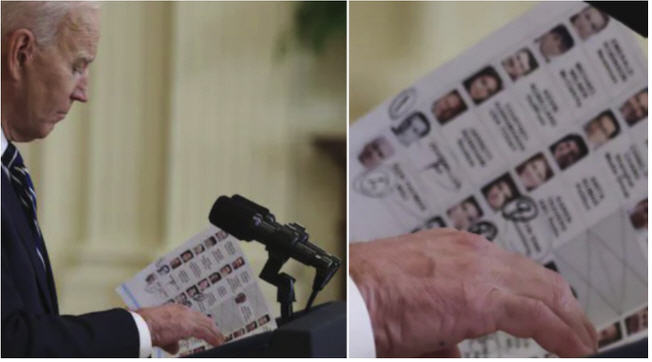
First up, I need to stress how impressed Socotra Publishing was with Mr. Biden’s performance yesterday. That is sincere, and not some set-up to a bad joke. The Press Conference was a big deal, and it went well. There were those who were whispering that it would devolve into some sort of mass melt down that would end the regime. The slip on the stairs going up to Air Force One was one of the things that set the expectations for possible disaster.
The disloyal opposition maintained the leader of the Free World could not handle some tough questions about multiple policies that do not seem to make a great deal of sense. Accordingly, I was alert and my medication was precise enough to be alert to see it. So, as I said, it was well-done, and I was proud the people who set it up did it pretty well. The President seemed able to understand the thrust of the questions, and did not mix up his prepared answers.
It anyone wants to contrast that with a Winston Churchill moment, of course that will fall a bit short. But it worked. The Press Conference lasted a couple minutes over an hour, and while his answers did not make a great deal of sense, they were in order. When he was done, he abruptly announced, “Folks, I’m goin’ ” and departed.
I like these kind of events, and I further like to see how it was done. The buzz that followed was a mix of gas-lit praise and dark speculation. If you start with the idea that our President arose that morning, got a shower and shaved before a quick breakfast and on-the-fly updates as he donned a neat, well-tailored suit and thought through what might be happening in the afternoon, then you might be a bit disappointed.
If, on the contrary, you thought that he instead was carefully raised from somnolence, appropriately medicated and groomed for a set-piece presentation you might be closer. What happened after that was to make a carefully scripted event appear to be an actual event with random and possibly pointed questions about things that do not seem to make a great deal of sense. That his answers did not seem to make sense is irrelevant and was not the point.
The sense of time distortion was inevitable, since the script was set before other breaking events. One of those things was the latest muted story about his son, Hunter. There was something about lying on the Federal Background Check about purchasing a legal pistol. The pistol in question wound up in a trashcan. It seems to be part of the same pattern of things like missing laptops and lapses of judgement that have been known for a while, but thankfully, despite the current hysteria about toughening gun laws for law-abiding citizens while ignoring the antics of the Presidential family, the matter did not come up.
So, watching the event was useful. I don’t know how many people were assigned to make it all work and what they did. Only parts of it were disclosed, like the call-order and the questions. Setting was important. If you saw it, the usual place for the Chief Executive is behind a podium in front of the door to the right of the long room. Normally, it is packed with reporters. This one was staged differently. The President was behind a podium, but near the windows on the far end of the room with a small number of reporters separated by an extensive social spacing. That is explained, of course, by the plague emergency. The editorial staff was split on watching while masked, so we understand.
The President has been vaccinated, of course, and I have no doubt all the reporters present were as well. But “framing” is important, and the optics, while a little strange, were explained by the continuing emergency.
We could not see what the President had with him, but after-the-fact imagery showed what he had. It appeared to be a double-sheet filled with images of reporters faces, with circled numbers next to them. If this has been done before, it was more clandestine. But it suggests that there was a predetermined order of reporters to be called upon, and in another post-facto image, we could see the scripted answers on longer sheets that the President read in response to scripted questions.
I have no problems with that- lot of issues, lot of possibilities. But the idea that this was an actual question-and-answer session is clearly false. And the answers, when they came, lacked much in the way of specifics. That too is expected, like calling the United States “86th” in global infrastructure. I checked while watching, and he got around to the right answer about the same time I did. “13th” is a commonly cited number.
I don’t know what means was used to communicate to Mr. Biden outside of what was permitted to be shown. I assume it is some sort of ear-bud. At one question, the President paused, looking blankly forward for five or six seconds. It seemed to me that someone helped hi with what to do, and with a smile, he was able to continue with a jumble of happy images of courageous children trekking across vast deserts, and moral just people welcoming them in their quest for freedom.
So, I was not disappointed. I think we got a clue about how hard it is to get one of these demonstrations together. Word spread on Monday that a “lid” was placed on his schedule last Monday at one-fifteen, the same time the Press event was scheduled yesterday. There is no direct connection, except to marvel at the coincidence in timing, and assume it was part of the rigorous preparation. That obviously may include medication to help sharpen the President’s acumen at the crucial moment, and there are consequences to that sort of regimen. But it worked this time.
Screen Shot 2021-03-26 at 10.19.06 AM.png
When I saw the pictures this morning, I laughed. The little thumbnails next to the names and the circled numbers were of bare-faced journalists, and of course they were actually all masked. They kept them on while asking their questions, which muffled them from the microphones to the audio, and must have been confusing for the President. Thankfully, both questions and answers were written down for the man on camera, and it came off pretty well. Mr. Biden has a long history of drift in his responses, but things like where we are on infrastructure, when the current filibuster practice was adopted in the Senate and what month illegal border crossings surge go by the board.
So, my praise to Mr. Biden for getting through it, and a note of congratulation to those who spent the week attempting to get him ready for it. The other question is still hanging this morning. If it took this much effort to do a simple press event, what on earth does it take to make actual policy decisions? And who is making them?
Copyright 2021 Vic Socotra
www.vicsocotra.com
Life & ISland Times: Crossing That Bridge
Months passed before I began to figure out what lay beneath and beyond my sight as I drove north over Savannah’s US Route 17 bridge.
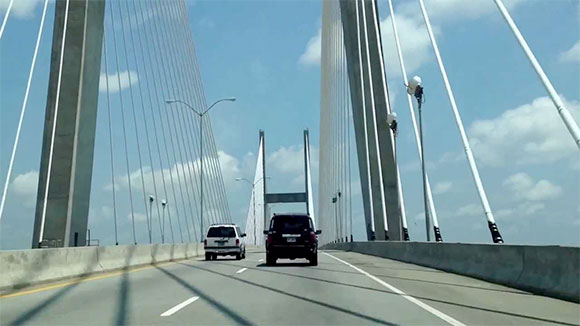
Do you know which bridge I mean? The memorial one named after Eugene, the former three term Georgia governor and bitter angel of the Jim Crow era, Talmadge.
There is no footwalk on this bridge from which to enjoy the nearly 200 foot high view. Absent from the bridge are bums sleeping, trysting couples, whiskey bottles and newspaper litter, graffiti and other myriad signs of that modern humanity leaves as signs that it has been there. The bridge is a unique observation tower that rarely is used for such.
I wanted to see what was out there so I was not discouraged by this inconvenience whenever I crossed it.
If I raise myself up from my seat and twist around, shift my weight without losing control of the car, rotate my head, and glance over my left shoulder, I see through the cascades of steel cables draped from the bridge’s two towers the silhouettes of dozens of huge container ship cranes upriver to the north in the modern deep water port of Savannah. Ships patiently wait pierside while these monsters pluck containers from the 100+ foot high stacks like mechanical monkeys plucking ticks from their family members backs.
Carefully pivoting to look over my right shoulder through the King Kong sized bridge harp strings, I see the historic downtown Savannah skyline flowing out oceanward to the eastern horizon.
If I slow the car’s pace and stay steady and focused, I can pick out the ever growing encirclement of renovated historic port city buildings courtesy of SCAD, River Street’s ribbon of cobbles and wharf buildings, the Cotton Exchange, the distant railroad crossing bridge pylons. Behind my back is the city’s low profile historic district. As the car summits the bridge, some of the city’s historic squares foliage blinks in and out of view.
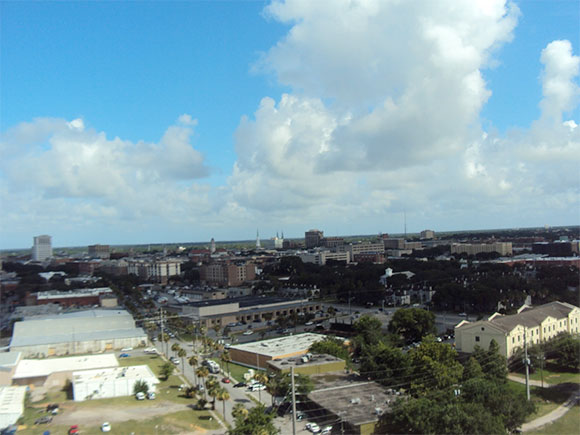
In the far distance along the riverbank, a life sized brass statue of the Waving Girl flaps her small clothe in perpetual welcome and farewell to the crews of the passing ships of the sea. Some of the smaller vessels toot at her in honor of her 44 years of such daily salutes. Gone but not forgotten, Florence.
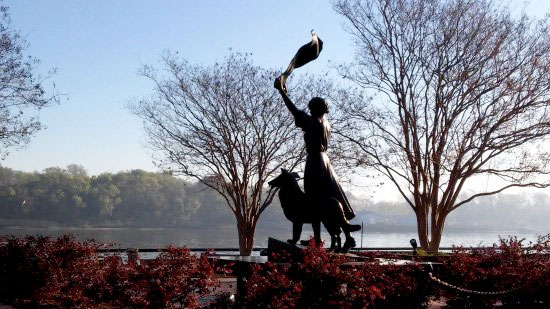
It dawns on me when crossing that bridge that what I see to the east on my right was the number one slave trading port in the US. This past was long ago replaced and not preserved as it was up in Charleston to the north.
Most who visit this river front are unaware of this unless they make an effort to read the history of the town. This past has all been obliterated from the physical city save for a local museum and a few historical markers. Just a few blocks north of our house is the corner of Abercorn and Gaston Streets where sat the original cemetery for African American slaves. As the city of Savannah grew and prospered in the mid 19th century, the need for more dwelling and commercial space caused the city to claim that acreage without even casting a thought to disinterring and reburying the dead it held. They just built over the graves.
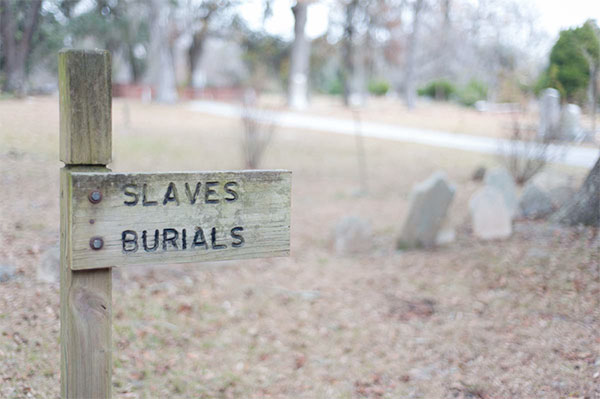
I realized a while ago that the past is never erased, just obscured. Some say this covering up is due to hate or guilt or politics. None of these seems to be the reason. Speed and money are what it’s about. Those others are just reasons that some use to keep others on their toes.
We are not ants who are bereft of eyes and sight. Nature does not waste eyes on lives spent entirely in the dark. She was exceedingly generous to us by providing us ears and cell phones to memorialize these bridge crossings in pictures as well as to search the web for answers to questions like these when they arise.
The river below the bridge sometimes shows off to the careful observer. Warm summer ripples scintillate under bright blue sky sunshine. Its water color differs depending on point of view, light, wind, season and the passing of ships. The Savannah shows all colors, no color, any color from the impenetrable brown of container ship propeller churned silt to pure glimmer. Its surface is like blank white writing paper, empty until someone fills it with some words that scamper across it until they vanish into a spray, then froth and finally bubbles as the captured thoughts and memories are swallowed whole and sink into the depths.
Meanwhile as the car begins its descent of the northern half of the bridge towards South Carolina, my hands tighten around the steering wheel in anticipation of the car accelerating towards the bridge’s sudden narrowing from two lanes to one. The river water ripples below, while the bridge rail imperceptibly seems lower opening up the bridge’s framing of the marshes in the Palmetto State. This bank is undeveloped. There are no people here for miles. Too wet and tidal. Only bugs and wildlife.
This place is not just growing on me. I am coming to like it and its people. A lot.
Copyright © 2017 From My Isle Seat
www.vicsocotra.com
Life and Island Times: Snake Eyes

This morning Marlow had the lead until the first gas and rest stop. It was going to be a long day of riding on two lane back country roads they had never seen or ridden. As Rex had not group ridden with Marlow in the lead, a short pre-brief was required.
“We all know back country road surfaces change from superb to dangerous with no warning. Consequently, when I lead, we will not follow cars or trucks for any period of time only to be suddenly surprised by unsafe road conditions. I will not pass unless I see there’s enough time and space for all four of us to complete the pass safely.
“I will signal you when we are about to pass with my left turn signal. On the second flash, I will downshift and begin to accelerate hard. You will hear my exhaust pipe barking. On the third flash, my throttle will be full wide open and I will commence the pass.
“You must stay close behind me and immediately follow. Do not look at your speedometer. How fast we will end up going during the pass is not important.
“If we want our pack to stay as one, pack integrity depends entirely on maintaining passing speed long enough for the last rider to duck in front of the last passed vehicle. So stick to the ass of the bike in front of you in a slight stagger. I will hold my course and speed until I see the last rider has tucked back in.
“I do not dice roll snake eyes when I make these maneuvers. Trust is a must in your lead. Otherwise some or all of us will get hurt. Any questions?”
Rex was an old school rider and did not flinch when he said, “Gotcha.”
Steve added, “Piece of cake.”
Augustus, ever the comedic Falstaff to Marlow’s Hal, chimed in “Wonder if we’ll top last year’s passing speed record of 108?”
“Bite me, girly man!” was Marlow’s standard reply.
The vehicle passes that morning were numerous, excellent and much needed. Road surface changes were abrupt and dangerous with unannounced chip seal road surfaces, rain squalls, unmarked oblique RR track crossings, slick roads, and logging truckload trailing debris storms.
At the end of his lead time, Marlow and his bike were spattered with mud, gravel, leaves, needles and twigs. His fellow riders were not, prompting Augustus to say, “Where’s a rake when I need one?”
Augustus and Steve split lead duties the next four hours. The mid-afternoon roads were now empty, dry and smooth.
The motorcycles were slicing through the sun drenched, flat black asphalt. The land beside the roadbed was getting wilder and deeply forested. Wildlife was lurking and posed existential hazards should it decide un-providentially to cross in front of them.
Raptors glided over their heads as if joining them on the ride.
The road was peaceful and straight ahead. They were sweating, under their leathers. They had worn them to protect against the early morning chill but now they were a detriment not a help. They kept wiping the sweat from their eyes and squinting to see the road. Augustus splashed some water on himself from an old used plastic bottle he kept between his windscreen and handlebars for such purposes.
At a rest stop ahead near a road side ditch creek, they stripped off their jackets. They greedily drank deeply from their water bottles.
Marlow and his bike were around the bend, since he had almost missed stopping. He had been riding fast to catch up to the pack when they had stopped without warning.
The forest around him was silent, mysterious and surprisingly stifling.
A snake slithered by him and dropped into the ditch. It swam with the same motion it had on land but with its head held higher. Its speed and directional control on water were better. After more than 50 feet of downstream progress, it turned starboard and exited the stream and entered the forest.
Marlow thought to himself, that they might have to watch for snakes on the road ahead since unsuspectedly squishing one might make our directional control a bit dicey.
Suitably refreshed, he cranked his bike back to life and without putting his helmet back on putted at idle in first gear back to the group. Rounding the corner, he could not believe his eyes. A group of three large snakes was making their way along the roadside and then veered directly at the trio of bikers. These were not little pit vipers, black or garter snakes. These were large Hollywood movie rattler bad boys with gleaming skins. The slimy squadron turned to cross the road and headed towards the group. The riders were unsuspecting since they were leaning on their bike saddles with their backs to the road, peering across the creek and into the forest.
He thought to yell a warning, but his barely muffled pipe brapping would cover his message. Instead he stood on his bike’s floorboards, goosed the throttle, and headed straight on an intersecting course with the snakes and their heads.
Picking off the first one was easy. As expected the bike became unstable, nauseatingly so, but it held firm. Squashed brains and snake carcass flopped in his rear view mirror.
The next two targets were moving faster, were much bigger and closer together. This would be difficult and dangerous by several factors. He decided to keep the tires on them a bit longer, so he slowed down a bit. Bad choice.
As he fixed his sites on these two slitherers, he recognized them as rattlers, but they were much, much bigger than those he had seen in the wilds of the Florida panhandle and northern Georgia. He was shaking on the inside. Sweat beads now obscured his visions. He struggled to steady the slow moving, 1000 pound bike.
The second one’s head was so big that it was like mounting a city street concrete curb. The bike rolled sickeningly over the snake as the bike cracked but not crushed its skull.
With the bike’s rolling and his adjustments to keep the bike straight up always lagging a bit behind, the third snake strike would be well aft of its head and at a higher rate of speed. This was not good. He and his bike hit the snake at a severe lean angle.
He then did what he knew better not to do. He looked down. Following the old motorcycle adage that you go where you look, Marlow and the bike slowly began to go down. As he fought to keep the bike upright, his right hand twisted the throttle wide open, accelerating the fall. As he spun downward, he saw that he had missed the snake’s head and only managed to piss it off.
Fortunately, the bike’s wildly spinning rear wheel had lofted this monster into the air and the other lane of traffic. Marlow managed to soften his head striking the hot pavement when he instinctively brought his gloved hands to his head.
Wham. Screeeeeeeeeeeeeech.
Pain and stars. But no darkness
He struggled to retain visual contact with the snake, since he and the snake were rolling in the same direction on the road. The bike was now on its side slowly skidding to a stop but fortunately fully blocking the lane of oncoming traffic. That was a very good thing.
There was the taste of blood in his mouth. He felt quite disoriented and very woozy. Fighting this, he finally regained visual on the third snake as it tumbled and writhed on the asphalt. Its eyes and mouth were headed straight at him. This was a very, very bad thing.
The boys were now alert to something behind them. They were still slowly taking in the situation. The third snake was no more than 10 feet from Marlow.
As he raised his arms in defense, an old black pickup truck swerved away from Marlow and bike and into the other lane, neatly trisecting the snake dead. A piece of the third snake’s tail rolled and stopped at his feet.
This ride’s wilderness theme had now officially become all too real.

The riders hurried to Marlow’s aid, picking up him and his bike.
“They had bad intentions.” exclaimed Marlow as he spit.
“Rattlers don’t travel in a group like that.” rejoined Rex, “At least not in Texas where I’m from.”
Steve was booting the dead snake parts off the road into a pile.
Augustus interjected, “I’ve seen momma snakes with their hatchlings travel as a group but never large adults. Adults might share a nest but they’re solitary hunters.”
Marlow added, “Snakes never make a beeline for larger creatures. Wonder if there’s a nest nearby?”
With that attention getter in the air, Steve, Rex and Augustus all turned to survey the ground around their bikes. They all had missed it.
There were multiple sets of the telltale marks that these snakes leave when they travel over loose surfaces. There was a large nest somewhere nearby.
Rex and Augustus like Marlow had taken survival classes in the wild during their time in the military. They had been taught these things.
One by one, while the rest of them stood watch over the approaches, the bikers relocated their rides with great urgency to where Marlow’s bike had originally rested.
After several minutes of chatter, they figured out once again that they were standing in the middle of a forest convulsing with snakes. They found deep rectilinear snake tracks in their new rest area.
Augustus commented as they mounted up again in search of a safe and now concrete-padded rest area, “Looks like it’s come down to who of us can survive and who can’t. If we fail to see things in sunlight, we’re screwed.”
This deep forest rest stop was a serpentarium.
The bikes with their bungee corded loads lurched off. Soon they entered the cluttered outskirts of another small town, past a near empty feed store, shuttered businesses, empty gas stations, boarded up houses, overgrown churches, rusted signs, and faded billboards. There were no cars moving about, let alone people in evidence. The gas station and concrete pad they were seeking was on the other side of town. It too had but one grade of gas.
All this decay made Marlow wonder. So, looking at Steve and Augustus who were waiting for Rex to finish filling his tank, he asked, “Is the country on the wrong path? Are we headed down a dead end alley? If small towns we are increasingly seeing aren’t surviving, could big cities and their softer and very dependent citizens last?”
As Marlow expected, Augustus emphatically said no; but, Steve, ever the optimist, said “They and we will last as long as we want it to and believe it will. Only when too many of the smart guys like you two stop belieiving it, then will the whole deal collapse. I take this as a matter of faith.”
Gus surprisingly and forcibly jumped in, “It’s gotten so complicated and effed up that no one in the imperial city will level with us . . . there’s a fair portion of folks out here who’d be okay if it all just fell apart and we started over . . . because they feel they will be among the survivors.”
Steve and Rex were taken aback. Marlow had heard this and what followed before. Many times.
“You know where I’m headed when it does? Right where we’ve been, right here and right where we’re going. It’s simple and it’s real.”
Marlow knew it was fruitless to argue with Augustus about how he saw the realities of pain, fear, killing, loss, dissolution and surviving. What Augustus saw coming was a personal and mass communal insantiy.
Rex and Steve saw this and were deeply unsetled by this exchange.
P.S. Had we been camping, we’d have eaten the snakes. With the right herbs, they’re better than Paula Deen’s chicken.
Copyright © 2017 From My Isle Seat
www.vicsocotra.com
1968
Annus Horribilis
I have been thinking a lot about bygone days, as my weary readers are well aware. It seems safer back there, though when one actually looks at it objectively, there have been a few rough spots in our national life. 1968 was one of them.
One correction to Marlow’s magnificent essay “Crossings” we published yesterday: the SS United States was operated, of course, by the United States Lines, not the venerable Cunard Lines of the United Kingdom. The editorial staff has been justifiably flogged, with thanks to alert readers around the world.
But going back to that fateful year also brought back some awful memories. Stop me if any of this seems familiar.
January
January 5
Dr. Benjamin Spock; William Sloan Coffin the chaplain of Yale University; novelist Mitchell Goodman; Michael Ferber, a graduate student at Harvard; and Marcus Raskin a peace activist are indicted on charges of conspiracy to encourage violations of the draft laws by a grand jury in Boston.
January 17
President Lyndon Baines Johnson (1908-1973) delivers the State of the Union Address about the Great Society and the war in Indochina, where a half million American troops are fighting.
January 23
North Korean patrol boats capture the USS Pueblo, a US Navy intelligence gathering vessel and its 83-man crew on charges of violating the communist country’s twelve-mile territorial limit.
January 31
At half-past midnight on Wednesday morning, the North Vietnamese launch the Tet offensive at Nha Trang.
February
February 1
During police actions following the first day of the Tet offensive General Nguyen Ngoc Loan, a south Vietnamese security official is captured on film executing a Viet Cong prisoner by American photographer Eddie Adams.
February 2
Richard Nixon, a republican from California, enters the New Hampshire primary and declares his presidential candidacy.
February 4
Dr. Martin Luther King delivers a sermon at his Ebenezer Baptist Church in Atlanta which will come to be seen as prophetic. His speech contains what amounts to his own eulogy. After his death, he says, “I’d like somebody to mention that day that Martin Luther King Jr. tried to give his life serving others. I’d like for somebody to say that day that Martin Luther King Jr. tried to love somebody… that I tried to love and serve humanity.”
February 7
International reporters arrive at the embattled city of Ben Tre in South Vietnam. Peter Arnett, then of the Associated Press, writes a dispatch quoting an unnamed US major as saying, “It became necessary to destroy the town to save it.”
February 18
The US State Department announces the highest US casualty toll of the Vietnam War. The previous week saw 543 Americans killed in action, and 2547 wounded.
March
March 12
The New Hampshire primary election brings shocking results. The Eugene McCarthy campaign, benefitting from the work of 2,000 full-time student volunteers and up to 5,000 on the weekends immediately preceding the vote comes within 230 votes of defeating the sitting president Lyndon Johnson.
March 16
Senator Robert Kennedy, former Attorney General and JFK’s brother, announces he will run for President against LBJ. The same day, troops from the Americal Division (23rd) conducted what would become known as the My Lai Massacre.
March 22
In Czechoslovakia, Antonin Novotny resigns the Czech presidency setting off alarm bells in Moscow. The next day leaders of five Warsaw Pact countries meet in Dresden, East Germany to discuss the crisis.
March 28
Martin Luther King Jr. led a march in Memphis that turned violent. After King himself had been led from the scene one 16 year old black boy is killed, 60 people are injured, and over 150 arrested.
March 31
President Lyndon Johnson delivers his address vowing to limit the war in Vietnam by halting bombing north of the 20th parallel and announces he will not seek re-election
April
April 4
Martin Luther King spends the day at the Lorraine Motel in Memphis working and meeting with local leaders on plans for his Poor People’s March on Washington. At 6pm, he is assassinated by James Earl Ray. His murder sparks rioting in Baltimore, Boston, Chicago, Detroit, Kansas City, Newark, Washington, D.C., and many others. Across the country 46 deaths will be blamed on the riots.
April 11
United States Secretary of Defense Clark Clifford calls 24,500 military reserves to action for two-year commitments, and announces a new troop ceiling of 549,500 American soldiers in Vietnam. The total number of Americans “in country” will peak at some 541,000 in August this year, and decline to 334,000 by 1970.
April 23
A rally and occupation of the Low administrative office building at Columbia University protesting the school’s association with defense contracting results in the further occupation of five buildings, which lasts a week before police storm the buildings and remove the students and supporters
May
May 3
The US and North Vietnamese delegations agree to begin peace talks in Paris later this month. The formal talks will begin on May 10.
May 6
In France, “Bloody Monday” marks one of the most violent days of the Parisian student revolt. Five thousand students march through the Latin Quarter with support from the student union and the instructors’ union. The fighting is intense with rioters setting up barricades and the police attacking with gas grenades.
May 11
Ralph Abernathy, Martin Luther King Jr.’s designated successor, and the Southern Christian Leadership Corps are granted a permit for an encampment on the Mall in Washington, DC. Eventually, despite nearly a solid month of rain, over 2,500 people will eventually occupy Resurrection City. On June 24th the site is raided by police, 124 occupants arrested, and the encampment demolished.
May 13
The actions taken by the students and instructors at the Sorbonne inspires sympathetic strikes throughout France. As many as nine million workers are on strike by May 22. President de Gaulle takes action to shore up governmental power. The show of force eventually dissipates the French revolutionary furor.
June
June 3
Andy Warhol is shot in his New York City loft by Valerie Solanis, a struggling actress, and writer.
June 4/5
On the night of the California Primary Robert Kennedy addresses a large crowd of supporters at the Ambassador Hotel in San Francisco. He has won victories in California and South Dakota and is confident that his campaign will go on to unite the many factions stressing the country. As he leaves the stage, he is shot by Sirhan Sirhan, a 24 year old Jordanian living in Los Angeles.
June 8
Robert Kennedy’s funeral is held at St. Patrick’s Cathedral in New York.
June 27
As the “Prague Spring” continues in Czechoslovakia, Ludvik Vaculik releases his manifesto “Two Thousand Words.” This essay is seen as a direct challenge to the Soviets, who begin planning for their invasion later in the summer.
June 28
A bill adding a 10% surcharge to income taxes and reducing government spending is signed by President Johnson. The president effectively admits it has been impossible to provide both “guns and butter.”
July
July 7
Abbie Hoffman’s “The Yippies are Going to Chicago” is published in The Realist. The Yippie’s will be in the center of action six weeks later at the Chicago Democratic National Convention, hosting a “Festival of Life” in contrast to what they term the convention’s “Festival of Death.”
July 24
At the Newport (Rhode Island) Folk Festival singer Arlo Guthrie performs his 20-minute ballad ‘Alice’s Restaurant” to favorable reviews.
August
August 8
At their Party convention in Miami Beach the Republicans nominate Richard Milhouse Nixon as their presidential candidate.
August 20
The Soviet Union invades Czechoslovakia with over 200,000 Warsaw pact troops, putting an end to the “Prague Spring.”
August 26
Mayor Richard Daley opens the Democratic National Convention in Chicago. While the convention moves haltingly toward nominating Hubert Humphrey for president, the city’s police attempt to enforce an 11 o’clock curfew. On that Monday night demonstrations are widespread, but generally peaceful. The next two days, however, bring increasing tension and violence to the situation.
August 28
By most accounts, on Wednesday evening Chicago police take action against crowds of demonstrators without provocation. 100 are sent to emergency rooms while 175 are arrested.
September
September 1
Democratic nominee Hubert Humphrey kicks off his presidential campaign at New York City’s Labor Day parade.
September 7
Women’s Liberation groups, target the Miss American beauty pageant in Atlantic City. The protest includes theatrical demonstrations including ritual disposal of traditional female roles into the “freedom ashcan.”
September 29
Thirtieth anniversary of Neville Chamberlain’s Munich agreement ceding Czechoslovakia’s Sudetenland to Hitler.
October
October 2
Police and military troops in Mexico City react violently to a student – led protest in Tlatelolco Square. Hundreds of the demonstrators are killed or injured.
October 3
George Wallace, who has been running an independent campaign for the presidency which has met significant support in the South and the Midwest, names retired Air Force Chief of Staff Curtis E. LeMay to be his running mate. LeMay advocates the use of nuclear weapons for peace.
October 11
Apollo 7 is launched from Florida for an eleven-day journey which will orbit the Earth 163 times.
October 12
The Summer Olympic Games open in Mexico City. On the 18th Tommie Smith and John Carlos, US athletes and medalists in the 200-meter dash will further disrupt the games by performing the black power salute during the “Star-Spangled Banner” at their medal ceremony.
October 20
Jacqueline Kennedy is married to Aristotle Onassis, a Greek shipping magnate on the private island of Skorpios.
October 31
President Johnson announces a total halt to US bombing in North Vietnam.
November
November 5
Election Day. The results of the popular vote are 31,770,000 for Nixon, 43.4 percent of the total; 31,270,000 or 42.7 percent for Humphrey; 9,906,000 or 13.5 percent for Wallace; and 0.4 percent for other candidates.
November 14
National Turn in Your Draft Card Day is observed with rallies and protests on college campuses throughout the country.
November 26
After stalling for months, the South Vietnamese government agrees to join in the Paris peace talks.
December
December 11
The unemployment rate, at 3.3 percent, is the lowest it has been in fifteen years.
December 12
Robert and Ethel Kennedy’s daughter, Rory, their eleventh child is born.
December 21
The launch of Apollo 8 begins the first US mission to orbit the Moon.
Compiled from multiple sources. I guess it could be worse. Rights reserved.
www.vicsocotra.com
We’ll Leave the Light On For You

I have been a traveling man most of my professional life. Mostly the unpleasant bag-dragging sort of travel in which you never really get to unpack, and wind up humping the luggage through elevators of varying reliability to cabs of uncertain hygiene to oppressive air portals of embarkation. Remember the stunning invocation of luggage with wheels? Technology on the march!
To the degree that there were no bags to drag, the cruising life represents travel in the grand manner.
On the big decks, it was remarkable. Someone would make Africa appear alongside the gray steel, or sampans ply the harbor below the big steel beach, or some exotic beach with rich land smells of flowers and crap and bus exhaust. You only had to drag your bag on at the beginning of the trip, and drag it off again some indeterminate time later.
The cast of reprobate Birdfarm sailors with whom I communicate have sailed the seven seas on aircraft carriers, which are funded by the Congress of the United States and managed by the hoteliers of the Department of the Navy. We began with a general attempt to provide a Michelin Guide to lodging in the Airdale Navy, but of course it got quickly into a recitation of a whole sub-culture, framed in showers and load noises and chow and broken sleep, and living amid machines already four decades old the first time we saw them.
So, the Michelin people would not actually visit the big ships to see how the button-crushers in the CV laundries were doing their jobs, or the quality of the Nairobi Trail Markers in the Dirty Shirt Wardroom, or where the coldest beer on the ship might be found in one of the Blind Pigs that operated sub-rosa in the old pre-Tailhook service.
Most of us were WESTPAC sailors, and most of the accounts I have are of the ships that went to the wars in SE Asia and the Persian Gulf. It was a busy time out there, but painfully different. Then, the South China Sea had no issues of sovereignty, nor a resurgent China with its own (albeit re-cycled) aircraft carrier. There is no doubt in my mind that it was more fun to serve on ours rather than theirs, but I will wait and see if the PLA-N issues me an invitation to review the wardroom fodder.
Anyway, this is not a case of Motel 6, where they leave the light on for you, but much closer to a review of Best Western Motels than a real Michelin Guide. You know the BW chain- often quirky, wildly different in amenities, uniquely themselves rather than some cookie-cutter corporate Holiday Inn Express. Some of us are old enough to have served on an actual Essex-class carrier, the mainstay of the WW II Navy.
![]()
(USS Ticonderoga, a 27C mod Essex hull. Photo USN).
My first ship was Midway, a late construction WWII ship with an armored steel deck and bristling with guns. She had two sisters: Coral Sea and Franklin D. Roosevelt.
Having dozens of the Essex hulls to spare, a modification was introduced (“The 27C mod”) that added an angle deck and steam catapults. Then came the FID-class boats- the Forrestal was “First in Defense,” (sisters Sara, Ranger, Indy) and they were quite remarkable in their day, and controversial, since the great debate still echoed about the role of the new Air Force and whether Navies (and armies) were still relevant in the Nuclear Age.
As it turns out, they were. But that is a matter for another day, and another discussion of whether past is prologue or just past. The old force was oil-fired and steam driven.
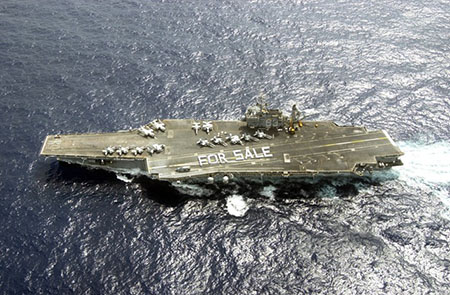
(Kitty Hawk wasn’t really for sale- but the Chinese could have bought a better ship).
The needs of empire spawned the workhorse ship of my time on the waves: Kitty Hawk and her kin (Connie and America), and the original Nuke, Enterprise and the remarkable sleek conventional JFK.
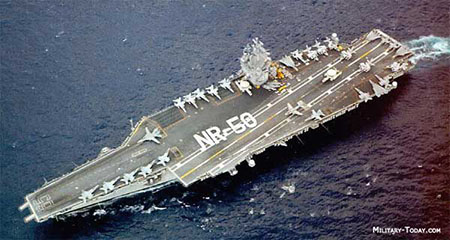
(USS Enterprise. First of the nukes. Photo Military Today).
Then came the ten ships that form the core of today’s carrier navy- the Nimitz-class ships. Cadillacs they are, by comparison with what came before, hybrid nuclear-steam machines that are wonders of 1970s technology.
Now, the USS Gerald R. Ford class is abuilding, and it will be a nuclear-electric beast, as will the two programmed sisters, the new Enterprise and JFK. I have the luxury of being skeptical about the whole thing. There is zero chance that I will wander down to the Dirty Shirt for a cup of cappuccino on the Ford when the hours are small and the horizon dark and impenetrable.
Regardless of the technology, one thing was common for the Airdale community, as opposed to the Surface Line and enlisted troops who lived below the hangar bay. We lived downstairs, if I may permitted the lubber term, but above the hangar bay, a palpable stratification of birdfarm social life. The air wing folks were lodged in bunkrooms and tiny staterooms wedged into spare space along the asbestos-lined catapult tracks. If you could learn to sleep through a launch cycle, you could properly call yourself a member of the extended-stay community.
My pal Point Loma wrote to support one of one of the old boats- the Coral Sea. I have to agree she got fairly short shrift in her treatment, and she had an advantage that the others did not have for me, personally. As the sister to Midway, I could always find my way to the dirty shirt and knew what they meant when they gave me a frame number and deck to navigate to. My pal commented thusly:
“Coral Maru was a good ship – I spent a day aboard her in the IO during a Gonzo Station turnover. But although she was a sister ship, she was not Midway.
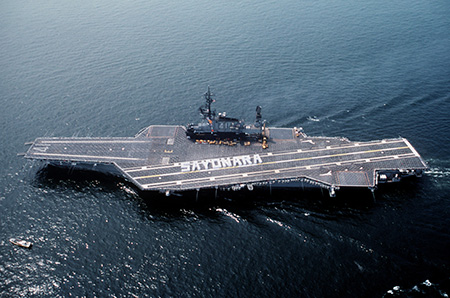
(USS Midway leaving her extended stay in Dai Nippon. Photo USN).
On Hotel 41, our mustang wardroom officer had been a Mess Specialist aboard the Pueblo, or People’s Museum Number FIVE as she is known in Pyongyang these days. The Mustang was a serial WESTPAC rat, so he may even had been there when you were. I wrote a review on a book about the Pueblo incident several years ago and mentioned him in the context that we weren’t done with the North Koreans, yet, and they had a habit of reminding us of that at inopportune moments.
One of our doughty Naval Academy grads decided one evening to rip the wardroom officer a new asshole, maybe because he had the duty and couldn’t eat in the dirty shirt, or his shrimp were overcooked or whatever. At any rate, he got up and publically started to berate the Mustang – we couldn’t believe it. You don’t do that sort of stuff in the dirty shirt, much less the formal Wardroom.
That provoked one of the older Mustangs seated at a table nearby. He walked up, got in the middle, and then proceeded to enlighten the Lieutenant as to whom he was abusing, as if his bullshit even was a pale comparison to the punishment he had endured from the DPRKs. There were all sorts of exiles and pirates associated with the Maru- they were there for the most part because part of themselves had been given to Asia and the Land of the Big PX did not hold the same allure as it did for the tourist sailors.
She was an interesting ship.
I remember well flinching at the shock of bleed air steam coming unexpectedly out of the handheld water devices in the showers- an exciting treat during the perfect Navy shower; that coming after various random blasts and spurts of hot and cold water.
Better yet – when you were totally soaped up and expectant of a semi-soothing hot water wash down, there was the reward of the “oh fuck” gurgle of nothing from the plastic beast, usually before a GQ was scheduled.
That experience was mostly aboard conventional (oil) powered carriers (and the Command Ship Coronado). Nimitz-class ships, being nukes with unlimited desalinization power- were much more reliable for hot water. And of course, there was the sweet fragrance, emollient and laxative effects of Jet Fuel #5 that only enhanced the CV spa experience.
This brings back a great memory. Around the corner from my stateroom aboard Midway on the starboard side inboard of Cat One on the 0-2 level (and just forward of the Switchbox Ready Room Two) was a semi-private head that had no outward compartment markings. It was four right turns out of the bunkroom (BK). Inside, there were three Hollywood shower stalls and in there you could turn on the taps and luxuriate under torrents of hot water just like at home – no fucking hand-held nozzles that forced compliance with the hated Navy wet-soap-rinse routine.
The head was a hidden, semi-private oasis and I never stood in line to get in, as if anything like that could be a secret aboard an aircraft carrier, ever, but it was. Another reason why I love and will always treasure that ship. I had almost forgotten that.
I became a shellback in 1981 aboard Kitty Hawk after joining VA-52 during a mid-cruise port call in Perth (a sea story in its own right) on the way back up to Gonzo Station. It was not a pleasant experience, but it is what it was. After that, I had the pleasure of being a sadistic trusty Shellback during a few more crossings. My outfit was typically pirate with a homemade bandana, sunglasses, shorts, flight boots, a t-shirt with a cartoon on it with the caption “Nuke the Wogs” and my shillelagh emblazoned with “I love sweet Wog ass” upon it, which I wielded with gusto.
As I was still worn out from the war (Clausewitz was right about the whole Friction thing), I skipped the last crossing aboard Midway Maru, choosing instead to sleep in. We were returning from DESERT STORM and dipped down south after passing Singapore to put an exclamation point on the combat cruise before a well-deserved port call in Pattaya Beach, Thailand.
(I began to chuckle at that, since my son is making his first port visit there soon. On the same ship in the same port, our A-6 Intruder Squadron had rented an Admin suite in one of the high-rise hotels. VA-115 prided itself on their bombing accuracy, and decided to conduct proficiency operations by precision-dropping some of the furniture off the balcony. It became their opportunity to “meet the Ambassador,” but I missed it, being ensconced at the Nana Hotel on Soi 4 up in Bangkok, and exploring the quite remarkable world of the Grace Hotel Coffee Shop, which after 0200 became the prototype for the Star Wars Cantina.)
My pal continued: “As we had missed several “beer days,” the Skipper (he was famous later) and XO (later an author) decide to combine the two. Since our CAG didn’t drink, I managed to talk our Admin Chief into giving me his beer tickets that I shared with the CVIC Supervisor (Carrier Intelligence Center) in his stateroom.
We had something like 15,000 cans of beer onboard which we couldn’t take back to Japan and instead of dumping them overboard, the XO ordered us to “drink it all.” During dinner down in the wardroom, I think I had another four beers – sort of like being back at the Atsugi O’Club. As we used to say, there is the right way, the wrong way, the Navy way, and the Midway. God, I love that fucking pirate ship.”
What is most remarkable is that you can visit her in San Diego Harbor. See, the point of this guide is that a handful of these ships will survive. Navies are expensive things, and the way of ships is to return to the iron oxide from whence they came. They become inconvenient and hard to keep from sinking on their own, and hence are scrapped for razor blades or sunk for reefs. So thanks for coming along for a visit to the lost world.
This won’t be the end of these stories, of course. There are a million of them. And the way you can tell a sea story from a fairy tale is that one starts out “Once upon a time,” and the other “This is a no-shitter, really….”
We will leave the light on for you.
Copyright 2014 Vic Socotra
www.vicsocotra.com
Twitter: @jayare303
